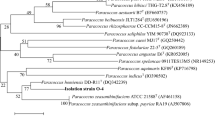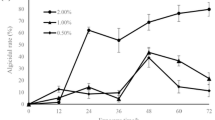Abstract
In this study, we examined the algal-lytic activities and biological control mechanisms of Pseudoalteromonas haloplanktis AFMB-08041, which was isolated from surface seawater obtained at Masan Bay in Korea. In addition, we assessed whether AFMB-08041 could be used as a biocontrol agent to regulate harmful dinoflagellate Prorocentrum minimum. From these experiments, we found that the inoculation of AFMB-08041 at a final density of 2.5 × 104 cfu ml−1 caused P. minimum cells to degrade (>90%) within 5 days. The algal cells were lysed through an indirect attack by the AFMB-08041 bacterial strain. Our results also suggest that the algal-lytic compounds produced by AFMB-08041 may have β-glucosidase activity. However, P. haloplanktis AFMB-08041 was not able to suppress the growth of other alga such as Alexandrium tamarense, Akashiwo sanguinea, Cochlodinium polykrikoides, Gymnodinium catenatum, and Heterosigma akashiwo. Moreover, we observed that the growth of Prorocentrum dentatum, which has a very similar morphological structure to P. minimum, was also effectively suppressed by P. haloplanktis AFMB-08041. Therefore, the effect of AFMB-08041 on P. minimum degradation appears to be species specific. When testing in an indoor mesocosms, P. haloplanktis AFMB-08041 reduced the amount of viable P. minimum cells by 94.5% within 5 days after inoculation. The combined results of this study clearly demonstrate that this bacterium is capable of regulating the harmful algal blooms of P. minimum. In addition, these results will enable us to develop a new strategy for the anthropogenic control of harmful algal bloom-forming species in nature.






Similar content being viewed by others
References
Adachi M, Fukami K, Kondo R, Nishijima T (2002) Identification of marine algicidal Flavobacterium sp 5 N-3 using multiple probes and whole-cell hybridization. Fish Sci 68:713–720
Amaro AM, Fuentes MS, Ogalde SR, Venegas JA, Suarez-Isla BA (2005) Identification and characterization of potentially algal-lytic marine bacteria strongly associated with the toxic dinoflagellate Alexandrium catenella. J Eukaryot Microbiol 52:191–200
Baumann L, Baumann P, Mandel M, Allen RD (1972) Taxonomy of aerobic marine eubacteria. J Bacteriol 110:402–429
Baumann P, Gauthier MJ, Baumann L (1998) Genus Alteromonas. Bergey’s manual of systematic bacteriology, vol. 1. 9th edn. Williams & Wilkins, Baltimore
Bowman JP (2007) Bioactive compound synthetic capacity and ecological significance of marine bacterial genus Pseudoalteromonas. Mar Drugs 5:220–241
Bradford MM (1976) A rapid and sensitive method for the quantitation of microgram quantities of protein utilizing the principle of protein–dye binding. Anal Biochem 72:248–254
Choi HG, Kim PJ, Lee WC, Yun SJ, Kim HG, Lee HJ (1998) Removal efficiency of Cochlodinium polykrikoides by yellow loess. J Kor Fish Soc 31:109–113
Chróst RJ (1989) Characterization and significance of β-glucosidase activity in lake water. Limnol Oceanogr 34:660–672
Di Ionno L, Messier PJ (2004) Lodinated thermal-fused polymer as a biocidal additive to commercial and chemical-resistant coatings. Surf Coat Int 87:265–272
Doucette GJ, Mcgovern ER, Babinchak JA (1999) Algicidal bacteria active against Gymnodinium breve (Dinophyceae). I. Bacterial isolation and characterization of killing activity. J Phycol 35:1447–1454
Droop MR (1967) A procedure for routine purification of alga cultures with antibiotics. Brit Phycol Bull 3:295–297
Egan S, Thomas T, Holmstrom C, Kjelleberg S (2000) Phylogenetic relationship and antifouling activity of bacterial epiphytes from the marine alga Ulva lactuca. Environ Microbiol 2:343–347
Felsenstein (1985) Confidence limits on phylogenies: an approach using the bootstrap. J Evol 39:783–791
Felsenstein J (1993) PHYLIP: phylogenetic inference package. University of Washington, Seattle
Fraleigh PC, Burnham JC (1988) Myxococcal predation on cyanobacterial populations: nutrient effects. Limnol Oceanogr 33:476–483
France J, Mozetic P (2006) Diversity and some ecological aspects of armored dinoflagellates in the Gulf of Trieste, the Adriatic Sea. Period Biol 108:159–168
Glöckner FO, Fuchs BM, Amann R (1999) Bacterioplankton compositions of lakes and oceans: a first comparison based on fluorescence in situ hybridization. Appl Environ Microbiol 65:3721–3726
Guillard RRL (1973) Division rates. In: Stein-Taylor JR (ed) Handbook of phycological methods. Cambridge University Press, Cambridge
Hare CE, Demir E, Coyne KJ, Cary SC, Kirchman DL, Hutchins DA (2005) A bacterium that inhibits the growth of Pfiesteria piscicida and other dinoflagellates. Harmful Algae 4:221–234
Heil CA, Glibert PM, Fan CL (2005) Prorocentrum minimum (Pavillard) Schiller—a review of a harmful algal bloom species of growing worldwide importance. Harmful Algae 4:449–470
Holmström C, Kjelleberg S (1999) Marine Pseudoalteromonas species are associated with higher organisms and produce biologically active extracellular agents. FEMS Microbiol Ecol 30:285–293
Holt JG, Krieg NR, Sneath PHA, Staley JT, Williams ST (1994) Gram-negative aerobic/microaerophilic rods and cocci. Bergey’s manual of determinative microbiology, 9th edn. Williams & Wilkins, Baltimore
Imai I, Sunahara T, Nishikawa T, Hori Y, Kondo R, Hiroishi S (2001) Fluctuations of the red tide flagellates Chattonella spp. (Raphidophyceae) and the algicidal bacterium Cytophaga sp. in the Seto Inland Sea, Japan. Mar Biol 138:1043–1049
Iwata Y, Sugahara I, Kimura T, Kowa H, Matsumoto A, Noritake K (2004) Properties of an algicidal bacterium (Flavobacterium sp.) against Karenia mikimotoi isolated from Ise Bay, Japan. Nippon Suisan Gakkai Shi 70:537–541
Jeong JH, Jin HJ, Sohn CH, Suh KH, Hong YK (2000) Algicidal activity of the seaweed Corallina pilulifera against red tide microalgae. J Appl Phycol 12:37–43
Kim JD, Han MS (2004) Enzyme profiles of alga-lytic bacterial strain AK-13 related with elimination of cyanobacterium Anabaena cylindrica. Kor J Environ Biol 22:184–191
Kim MS, Lee KA (2006) Antithrombotic activity of methanolic extract of Umbilicaria esculenta. J Ethnopharmacol 105:342–345
Kim JD, Kim B, Lee CG (2007) Alga-lytic activity of Pseudomonas fluorescens against the red tide causing marine alga Heterosigma akashiwo (Raphidophyceae). Biol Control 41:296–303
Kimura M (1980) A simple method for estimating evolutionary rates of base substitution through comparative studies of nucleotide sequence. J Mol Evol 16:111–120
Klappenbach JA, Saxman PR, Cole JR, Schmidt TM (2001) rrndb: the Ribosomal RNA operon copy number database. Nucleic Acids Res 29:181–184
Lee MO, Kim JK (2008) Characteristics of algal blooms in the southern coastal waters of Korea. Mar Environ Res 65:128–147
Lovejoy C, Bowman JP, Hallegraeff GM (1998) Algicidal effects of a novel marine Pseudoalteromonas isolate (class Proteobacteria, gamma subdivision) on harmful algal bloom species of the genera Chattonella, Gymnodinium, and Heterosigma. Appl Environ Microbiol 64:2806–2813
Lund JWG, Le Cren ED (1958) The inverted microscope method of estimating algal numbers and the statistical basis of estimations by counting. Hydrobiologia 11:143–170
Manage PM, Kawabata Z, Nakano S (2001) Dynamics of cyanophage-like particles an algicidal bacteria causing Microcystis aeruginosa mortality. Limnology 2:73–78
Mayali X, Azam F (2004) Algicidal bacteria in the sea and their impact on algal blooms. J Eukaryot Microbiol 51:139–144
Mayali X, Doucette GJ (2002) Microbial community interactions and population dynamics of an algicidal bacterium active against Karenia brevis (Dinophyceae). Harmful Algae 1:277–293
Middelbö M, Søndergaard M, Letarte Y, Borch NH (1995) Attached and free-living bacteria: production and polymer hydrolysis during a diatom bloom. Microb Ecol 29:231–248
Mu RM, Fan ZQ, Pei HY, Yuan XL, Liu SX, Wang XR (2007) Isolation and algae-lysing characteristics of the algicidal bacterium B5. J Environ Sci China 19:1336–1340
Na GH, Chio WJ, Chun YY (1996) A study on red tide control with loess suspension. Kor J Aquacult 9:239–245
Nakamura Y, Hirata A (2006) Plankton community structure and trophic interactions in a shallow and eutrophic estuarine system, Ariake Sound, Japan. Aquat Microb Ecol 44:45–57
Nigam P, Armour G, Banat IM, Singh D, Marchant R (2000) Physical removal of textile dyes from effluents and solid-state fermentation of dye-adsorbed agricultural residues. Bioresour Technol 72:219–226
Parsons TR, Maita Y, Lalli CM (1984) A manual of chemical and biological methods for seawater analysis. Pergamon, New York
Porter KG, Feig YS (1980) The use of DAPI for identifying and counting aquatic microflora. Limnol Oceanogr 25:943–948
Roth PB, Twiner MJ, Wanga Z, Dechraoui MYB, Doucette GJ (2007) Fate and distribution of brevetoxin (PbTx) following lysis of Karenia brevis by algicidal bacteria, including analysis of open A-ring derivatives. Toxicon 50:1175–1191
Roth PB, Mikulskil CM, Doucette GJ (2008) Influence of microbial interactions on the susceptibility of Karenia spp. to algicidal bacteria. Aquat Microb Ecol 50:251–259
Ryu HY, Shim JM, Bang JD, Lee C (1998) Experimental chemical treatment for the control of dinoflagellate, Cochlodinium polykrikoides in the land-based culture of olive flounder Paralichthys olivaceus. J Aquacult 11:285–294
Saito N, Nei M (1987) The neighbor-joining method: a new method for reconstructing phylogenetic trees. Mol Biol Evol 4:406–425
Sakata T, Fujita Y, Yamamoto H (1991) Plaque formation by algicidal Saprospira sp. on a lawn of Chaetoceros ceratosporum.. Nippon Suisan Gakkai Shi 57:1147–1152
Skerratt JH, Bowman JP, Hallegraeff G, James S, Nichols PD (2002) Algicidal bacteria associated with blooms of a toxic dinoflagellate in a temperate Australian estuary. Mar Ecol Prog Ser 244:1–15
Steinberger KA (1983) A reevaluation of toxic dinoflagellates biology and ecology. Prog Phycol Res 2:147–188
Stoecker DK, Adolf JE, Place AR, Glibert PM, Meritt DW (2008) Effects of the dinoflagellates Karlodinium veneficum and Prorocentrum minimum on early life history stages of the eastern oyster (Crassostrea virginica). Mar Biol 154:81–90
Su RQ, Yang XR, Zheng TL, Tian Y, Jiao NZ, Cai LZ, Hong HS (2007) Isolation and characterization of a marine algicidal bacterium against the toxic dinoflagellate Alexandrium tamarense. Harmful Algae 6:799–810
Sun XX, Choi JK, Kim EK (2004) A preliminary study on the mechanism of harmful algal bloom mitigation by use of sophorolipid treatment. J Exp Mar Biol Ecol 304:35–49
Tamura K, Nei M, Kumar S (2004) Prospects for inferring very large phylogenies by using the neighbor-joining method. PNAS 101:11030–11035
Tamura K, Dudley J, Nei M, Kumar S (2007) MEGA4: Molecular evolutionary genetics analysis (MEGA) software version 4.0. Mol Biol Evol 24:1596–1599
Toncheva-Panova T, Ivanova J (2000) Influence of physiological factors on the lysis effect of Cytophaga on the red microalga Rhodella reticulata. J Appl Microbiol 88:358–363
Warren RA (1996) Microbial hydrolysis of polysaccharides. Annu Rev Microbiol 50:183–212
Willen E (1976) A simplified method of phytoplankton counting. Br Phycol J 11:256–278
Yoshinaga I, Kawai T, Ishida Y (1997) Analysis of algicidal ranges of the bacteria killing the marine dinoflagellate Gymnodinium mikimotoi isolated from Tanabe Bay, Wakayama Pref, Japan. Fish Sci 63:94–98
Zheng TL, Su JQ, Maskaoui K, Yu ZM, Hu Z, Xu JS, Hong HS (2005) Microbial modulation in the biomass and toxin production of a red-tide causing alga. Mar Pollut Bull 51:1018–1025
Acknowledgements
This work was supported by the 21C Frontier Microbial Genomics and Applications Center Program (MG08-0305-1-0), Ministry of Education, Science, and Technology, Republic of Korea for which the authors are thankful.
Author information
Authors and Affiliations
Corresponding author
Rights and permissions
About this article
Cite this article
Kim, JD., Kim, JY., Park, JK. et al. Selective Control of the Prorocentrum minimum Harmful Algal Blooms by a Novel Algal-Lytic Bacterium Pseudoalteromonas haloplanktis AFMB-008041. Mar Biotechnol 11, 463–472 (2009). https://doi.org/10.1007/s10126-008-9167-9
Received:
Accepted:
Published:
Issue Date:
DOI: https://doi.org/10.1007/s10126-008-9167-9




